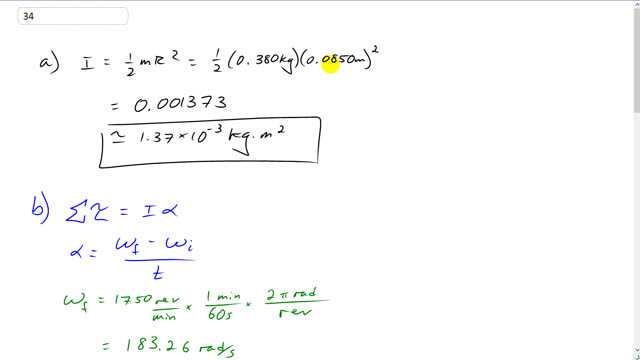
A grinding wheel is a uniform cylinder with a radius of 8.50 cm and a mass of 0.380 kg. Calculate
- its moment of inertia about its center, and
- the applied torque needed to accelerate it from rest to 1750 rpm in 5.00 s.

In order to watch this solution you need to have a subscription.
This is Giancoli Answers with Mr. Dychko. The moment of inertia for a uniform cylinder is one-half mass times its radius squared so that's one-half times 0.380 kilograms times 0.0850 meters squared— we are expressing the radius in meters instead of centimeters there— and we get 1.37 times 10 to the minus 3 kilogram meter squared. The total torque that is the applied torque combined with the friction torque together makes the moment of inertia times the angular acceleration. So we'll first figure out what this angular acceleration is gonna be and knowing that it achieves a final angular speed of 1750 rpm and we convert that rpm into radians per second by multiplying by 1 minute for every 60 seconds and then by multiplying by 2π radians for every revolution and we get 183.26 radians per second. It starts off at rest so that's just 0 for ω i and so the angular acceleration is gonna have to be 36.6519 radians per second squared and so that's what we'll plug in here because the applied torque is contained within this Στ thing. So Στ means the sum of all the torques and there are two of them: one is the applied torque and the other one is the friction torque that's gonna go working against it. So the friction torque we can figure out based on this data about the wheel coming to a rest in 55 seconds when it starts with a speed of 1500 rpm and then in that case when it's just free to slow down on its own, the friction torque is the net torque in which case it equals the moment of inertia times the angular acceleration that occurs then and that angular acceleration is the final angular speed of zero because it comes to a stop and minus the initial angular speed of 1500 rpm converted into radians per second and then divide that by 55 seconds and that gives negative 2.85599 radians per second squared and then knowing that we'll figure out the frictional torque although we are actually gonna factor out the moment of inertia here as you'll see. So rewriting this line here for the total torque; total torque is the applied torque plus the frictional torque equals moment of inertia times the acceleration that occurs, you know, when this applied torque is being applied and this is not the angular acceleration when the wheel is freely coming to a rest that was what we used up here. Okay so we are gonna subtract the frictional torque from both sides to solve for the applied torque which is what we have to answer here: what is the torque that needs to be applied in order to make this acceleration here happen And so we get that the applied torque is moment of inertia times angular acceleration minus the frictional torque and the frictional torque is moment of inertia times the frictional angular acceleration and then they both have this common factor, I, moment of inertia so let's factor that out and so we have the applied torque then is moment of inertia times angular acceleration when this applied torque is being applied minus the angular acceleration when the wheel is freely coming to rest due to only friction and plug in numbers. 1.373 times 10 to the minus 3 kilogram meter squared— moment of inertia—times 36.6519 radians per second squared— angular acceleration minus negative so note those two negatives there are gonna make a plus and that makes sense because we expect the applied torque will have to be greater as a result of this friction being in the way and so we would expect that this extra friction term here should increase the applied torque so we would expect this to work out to a plus. And our answer is 5.42 times 10 to the minus 2 newton meters is the applied torque required.